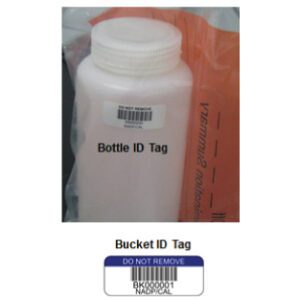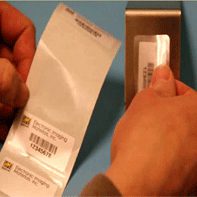When it comes to handling chemicals in laboratories, regulatory standards are crucial to safety and compliance. Properly labeled chemicals help employees handle substances safely, prevent accidents, and ensure proper inventory management. But what are the requirements for chemical labels? This blog walks you through the essential steps businesses should follow to ensure chemical labels meet regulatory standards, using best practices to make your labels as effective and safe as possible.
By providing the following information, you can help your laboratory stay compliant and safe.

1. Clear Identification
A key requirement for chemical labels is clear identification. Each label should identify the chemical by name, including its chemical or common name. This helps everyone in the lab or facility know exactly what they’re handling. Imagine if a bottle simply had “Chemistry Solution” on it—no one would know exactly what it was or how to handle it! Identifying each chemical with precision helps prevent confusion and accidents.
2. Hazard Information
Hazard information on chemical labels is crucial for safety. According to OSHA guidelines, it’s essential to list specific hazards on chemical labels. This includes hazard statements (like “flammable” or “corrosive”) and precautionary statements (such as “keep away from heat”). Hazard information is vital because it alerts anyone handling the chemical to potential risks, helping to avoid dangerous situations.
3. Manufacturer Details
Manufacturer details are another key component of compliant laboratory labels. Including the manufacturer’s name, address, and contact information helps in the event that there is an issue or question about a chemical. This is especially important if your lab works with multiple suppliers—knowing exactly who manufactured a specific chemical saves time and effort in tracking down information if needed.
4. Date of Preparation
Knowing when a chemical was prepared is essential. Many chemicals have a limited shelf life, and over time, they may lose potency or become hazardous. Including the date of preparation helps users know whether a chemical is still safe and effective to use. It also assists with inventory management by allowing labs to use older chemicals first, reducing waste.
5. Expiration Date
Expiration dates play an important role in chemical safety. Like the date of preparation, the expiration date tells users when a chemical is likely to become less effective or potentially hazardous. Chemical labels with expiration dates help prevent outdated substances from being used, keeping lab experiments and work accurate and safe.
6. Proper Labeling of Chemicals
Ensuring chemicals are labeled correctly means following any industry-specific standards, such as OSHA’s Hazard Communication Standard. For instance, labels should include a chemical’s name, hazards, and specific handling instructions. Proper labeling helps avoid accidents and ensures that even new staff can identify and handle chemicals safely.
Want to learn more about labeling functions within laboratories? Get the rundown on laboratory barcode labels and how they work.
7. Label Durability
Chemical labels need to be durable. Laboratories are often busy and messy places, and labels might be exposed to water, chemicals, or heavy handling. Chemical-resistant labels are essential for ensuring information remains clear and readable over time. This durability is especially important if chemicals are stored in extreme conditions, such as freezers where ordinary labels may fade or peel off.
8. Legibility
Legibility is a key aspect of effective labeling. If someone can’t read a label, then it doesn’t serve its purpose. Legibility includes not only clear, easy-to-read fonts but also colors that stand out against the chemical container. Choose label fonts that are large enough to read easily and avoid styles that are too decorative.
9. Color Coding
Color coding is an easy way to help staff quickly identify specific types of chemicals. For example, red could be used for flammable chemicals, blue for corrosive chemicals, and green for non-hazardous substances. This system makes it easier for lab workers to distinguish between substances at a glance, improving safety and efficiency.
10. Secondary Container Labeling
Sometimes, chemicals are transferred from their original containers into secondary containers. In these cases, it’s important to label the secondary container just as clearly as the original. Secondary containers are often used for temporary storage, but they should still be labeled with the chemical’s name and key safety information. OSHA requires secondary containers to be labeled if chemicals are not immediately used. Proper secondary labeling ensures that chemicals are safely managed, even when transferred.

Phil B. | OriGen Biomedical
“The customer service is always exceptional, the quality of the labels and the turn-around time is amazing.“
11. Compliance-Based Labeling
It’s essential to know and comply with the regulations that apply to your chemical labels. OSHA, GHS, and other industry standards outline specific requirements for labeling that businesses need to follow. Compliance means using the right symbols, hazard warnings, and handling instructions. Staying compliant can protect your lab from fines while also promoting a safer working environment.
12. Sample Traceability
Traceability allows laboratories to track the history of a sample. For chemical labels, this may mean including batch numbers, dates, and preparation information. Sample traceability is important for research and quality control, ensuring that every sample’s journey through the lab is well-documented. With traceability, labs can verify that chemicals have been handled and stored correctly, reducing errors and protecting sample integrity.
Why Electronic Imaging Materials Is Your Go-To for Top-Quality Chemical Labels
At Electronic Imaging Materials (EIM), we understand how essential clear, durable chemical labels are for regulatory compliance and lab safety. Our labels offer features that make labeling easy and reliable, from customized vial and test tube label sizes to medical device labels.
EIM’s chemical-resistant labels are also designed to withstand harsh conditions, ensuring that they remain legible and intact even when exposed to chemicals or extreme temperatures. We work with each client to ensure the right label solution for their needs, creating high-quality, compliant labels that meet regulatory standards. Whether your lab needs long-lasting, high-durability labels or simple, clear labels for everyday use, EIM can help.
The Bottom Line
When it comes to labeling chemicals in the lab, regulatory compliance is critical to safety and organization. Labs can stay compliant and safe by following these key steps—clear identification, hazard information, manufacturer details, date of preparation, and so on. Remember that label durability, legibility, and secondary container labeling also play important roles in maintaining safety.
Working with a trusted provider like Electronic Imaging Materials can make all the difference. With EIM’s custom color-coded, chemical-resistant labels, your lab can meet the strictest standards while keeping staff safe and chemicals properly labeled. Choosing the right chemical labels isn’t just about compliance—it’s about creating a safer, more organized lab environment.
Stay Compliant and Safe with EIM
Ensure your lab meets the highest regulatory standards with durable, customizable chemical labels from Electronic Imaging Materials. Discover how our expert labeling solutions can protect your staff and improve your inventory management.





